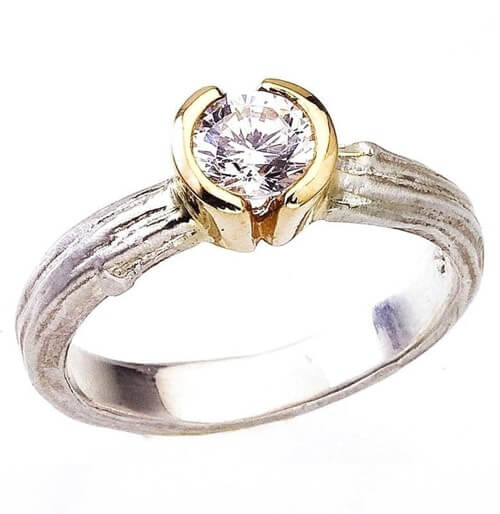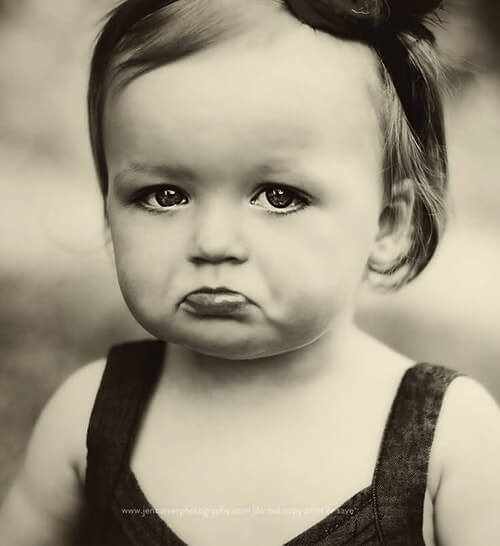While prongs act as little claws (beautiful, golden claws) that hold the diamond in place, the bezel setting works by encircling the diamond in a strip of metal, like a tiny expensive hug. Sometimes the hug is all-encompassing, like one you would get as a kid from your Grandma (that’s a ‘full bezel setting’ – like the picture above), while sometimes the hug is a little more standoffish, like a hug from your super cool Aunt Lauren who hates kids (that would be a ‘partial bezel setting’). Behold:

Almost... But Not Quite. She Tryin' Tho.
Whether you go for ‘The Grandma’ or the ‘Aunt Lauren’ is completely up to you, but as you will see in the handy ‘Pros & Cons’ list I have laboriously prepared for you, both types of bezel have earned their place on that ring finger.
Pros of Bezel Settings
In my humble opinion, the absolute best thing about a bezel set diamond engagement ring is the protection it gives to the diamond itself. That baby is going NO-WHERE. The strip of metal is not going to loosen or bend like prongs have been known to do. Nope. That little ring of precious metal is going to sit just over the girdle of the diamond (the widest, thinnest, most vulnerable part of the stone) and save it from any unsavoury bumps and chips it might otherwise encounter. In fact, the bezel setting works particularly well for those fancier diamond shapes that have sharper, pointer edges such as pear cut, marquise cut or princess cut diamonds…. Those little gems will be safe and snug inside that ring of gold.

Other plus is that this tiny ring of metal also means no snagging! Yup, the days of destroying your tights or tearing your gloves or snagging on a sweater sleeve are gone! The smooth edges of a bezel set diamond mean no catching, no scratching and no snagging… #ClawlessButFlawless
This no-fuss, snag-free option is great if you work with your hands or have a very active lifestyle this could be the ring style for you! That’s because a bezel set diamond also tends to sit lower than a traditional prong set stone, meaning there’s less opportunity for you to knock it against things.
One final, but significant, upside to choosing a bezel ring is that it can be very effective at hiding any nasty chips, inclusions or flaws in the diamond – especially if those flaws are sitting closer to the edge of the diamond itself. Just pop that diamond in a bezel set ring and pretend like nothing is amiss! Now, obviously this cunning little trick only works if the flaw is at the edge of the diamond… it’s not going to disguise a black inclusion right in the middle of the stone you guys!

Cons of Bezel Settings
We’ve ridden the highs, and now we must face the lows. So what’s less than ideal about the bezel setting? Well for one, they are more expensive. Yeah, it doesn’t take a Nobel Prize winning economist to see that more metal = more money. While prongs/claws are somewhat flimsier, they are smaller and therefore use up less metal. Our no-fuss bezel setting on the other hand, is far more robust and so it will leave you with a bit less cash in that pocket book.
It’s not just the amount of metal used that can impact the price. The level of expertise and skill needed to create a bezel setting can hike up the cost as well. This is because each bezel ring setting is custom made to fit your exact diamond, and this skill can be costly. It is certainly worth getting this done correctly however, as a poorly made ring can make the next downside of bezel settings even more pronounced; a lifeless diamond…

That’s right folks, bezel settings can steal the thunder from your hard-earned diamond! The horror. This is because the ring of metal that helps us keep the diamond safe (hurrah!) also stops that all important light from entering the stone (boo!). As you will remember from previous posts (you’ve read all of them of course), diamonds need light! They want to pull in all that lovely light from the world around them inside, and then bounce it around for a while before throwing it back out again because they’ve got an early meeting in the morning. The problem is, the bezel setting stops some light from entering and leaving, which can (but not always) mean a diamond with a little less sparkle and pizzazz.

I Feel You, Girl
But wait! There are ways to get around this nasty turn. Remember when I told you about ‘partial bezel settings’? Yup, those half huggers. These are fantastic at helping to negate the loss of light and sparkle from a stone, as you are covering less of it! Not only that, but a partial (half) bezel will also cut down on the cost AND even make the diamond appear larger! Obviously, the partial bezel means that less of your stone is protected from the outside world, but that is a trade off that you guys/gals can decide for yourselves.
One final (small) downside on bezel settings; can be tricky little hugger buggers to clean! Because of the nature of the setting itself, dirt, grime and general disgustingness can get lodged in underneath the setting, in between the ring and the diamond. This might not seem like a big deal, but think back to what I said about the need for light! The more obstruction there is (be it metal or dirty) will stop that light from getting in an working its magic on the diamond. Do not fret though, like always, there’s a work-around. Before you say it, no, I do not mean using a safety pin or toothpick, so don’t even go there. Sharp object like that could very easily cause damage, leaving you crying like a baby. Instead, simply grab that old tooth brush that you still have in your bathroom cabinet, run it under some warm soapy water and get to work gently dislodging the disgustingness from underneath/inside the setting itself. MAGIC!

